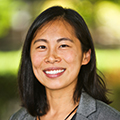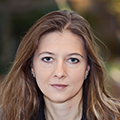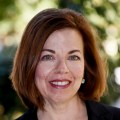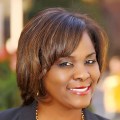For anyone watching the U.S. election cycle, it is easy to see why many women are so frustrated. For the first time in U.S. history, six women ran for the Democratic nomination for president, and despite their qualifications and diverse backgrounds, they were beaten out by two white men in their seventies. Though women constitute a majority of the country’s population, they only make up roughly 25 percent of the U.S. Congress, and only four women are currently serving in cabinet-level positions in the executive branch. The numbers are even less representative in state legislatures and governorships.
Perhaps the starkest visual examples of the lack of women in leadership positions can be seen in the numerous photographs documenting high-level meetings in the Trump administration. These photos (most recently of a high-level meeting about tackling the coronavirus threat) often show a majority of men—and in some instances only men—at the table. So, for this International Women’s Day, I asked some of the female scholars and executives at Brookings about their experiences as women in their fields and what their professions would look like if there were more women at the table. Their responses were both inspiring and optimistic and underscore the significant contributions women have made to their fields already. Here is what they had to say.
Emily Horne
Vice President, Communications

Communications and public relations is one of the few fields where both women’s participation and leadership is a relative bright spot in the U.S. labor market. As of 2019, the Bureau of Labor Statistics reports women compose 63.6 percent of U.S. public relations specialists and 71.4 percent of PR and fundraising managers (notably, they are also overwhelmingly white—83.6 percent and 89.8 percent, respectively). It’s not a uniformly positive story; there are significant variations across the field. My own background is in national security and crisis communications, subfields that are typically coded as more male-friendly than fields like marketing, event planning, or consumer/lifestyle public relations. This has meant that when I’m representing the communications vertical at a video teleconference planning a counterterrorism operation or in a tabletop exercise gaming out a scenario, I’m more likely to be in a male-dominated environment. It can be challenging in such environments to feel like I’m representing not just my professional field but my gender whenever I offer an opinion or assert a fact, but I try to see this as a privilege and responsibility.
Because PR and communications enjoy comparatively high participation of women at both the staff and leadership levels, the work itself can at times be viewed through a gendered frame. I have certainly worked in environments where the strong impression was the policymaking or operations function was more of a “male” world, whereas communications was coded as women-owned. This definitely felt more acute early in my career, and in recent years I’ve felt much more of a blur of those categories having had the privilege to work with amazing women leading policy and management teams. But too often communications is not in the room when policy decisions are being made, and is only brought in after the fact. I sometimes wonder if that’s a legacy of the misperception that communications is women’s work, and therefore is not taken seriously as part of a decision-making or policymaking process.
A good comms pro is collaborative, detail-oriented, and always thinking three steps ahead of the rest of the team. She needs to see around corners, anticipate both good and bad faith responses to the work, and understand who the audience is, where they are, and what they need. She is curious, empathetic, and can cut quickly to the heart of a complex issue. There is nothing inherently female about these talents, nor do I think women are necessarily predisposed to have these skills more than men, but my own (personal and highly unscientific) experience has been that women are more likely than men to be socialized to feel responsible for the emotions and needs of those around them. The expectation that women should more naturally perform this kind of emotional labor—and make no mistake, it is labor—than men is unfair and more than a little sexist.
But the reality of living within it for much of my life has given me a professional edge as a communicator. I’m sensitive to the fact that as a communicator, I’m ultimately responsible not just for what people hear and how they receive information, but how they feel about how they receive it. Do they feel respected, listened to, met where they are? Do they believe the messenger as well as the message? Are they inspired to want to hear more? That I as a woman do this work instinctually for people in my personal life is one of my secret weapons in my professional life.
Lauren Bauer
Fellow, Economic Studies

As an interdisciplinary researcher, I highlight three women whose careers shed light on why women are critical voices in research and policymaking. These women worked on fundamental questions—how do we work together, how do we age, how do we improve well-being—by breaking the mold and breaking down disciplinary silos. They tilled new fields.
Bernice Neugarten was the first person in the world to receive a PhD in human development. She became the country’s preeminent expert on gerontology, and developed and founded the interdisciplinary graduate program from which I received my doctoral degree, the Human Development and Social Policy program at Northwestern. Elinor Ostrom was a political scientist whose research on the commons won the Nobel Prize for Economic Sciences and whose workshop takes an explicitly interdisciplinary approach to working on the world’s most complex problems. And of course, Alice Rivlin, the model for evidence-based policymaking, who as the founding director of the Congressional Budget Office and at the Office of Management and Budget among other stints in public service, applied a disciplined approach to policy analysis. I am grateful for their example and work in bringing more women to the table.
Rebecca Winthrop
Co-Director, Center for Universal Education, Senior Fellow, Global Economy and Development
Emiliana Vegas
Co-Director, Center for Universal Education, Senior Fellow, Global Economy and Development
Christina Kwauk
Fellow, Center for Universal Education, Global Economy and Development



In many ways the answer to this question depends on where you sit in the world. For example, in some parts of the world the field of education already has a lot of women at the table. Take Brookings’s own Center for Universal Education: we have a team that consistently is made up of 80 to 90 percent women. In our hiring process, if we have two candidates of equal ability and one is a man and one is a woman, we would select the male candidate in order to improve our gender diversity. For a number of years, Brookings had a wonderful initiative, “the women’s mentoring network,” that was dedicated to mentoring young women in advancing their careers. We at CUE choose to participate only nominally in this network in part because every year we were actively involved in providing advice and guidance to the dozens of women within our own center and in part because we also recognized that an important strategy for improving gender diversity was to reach out and mentor young men wishing to enter the field of education.
But this dynamic does not hold across all contexts. Although in a number of countries the teaching workforce is predominantly female, many leadership positions in global education are filled by men. For example, in Southeast Asia and sub-Saharan Africa, a majority of school heads are male. Many of the countries in these regions have large gender gaps in educational achievement and having women at the table in these contexts means that there is more opportunity for the barriers and discriminatory norms challenging girls’ educational outcomes to be addressed by education systems. In countries where men occupy the majority of decision-making seats, it’s unlikely girls’ needs will be taken into account, perpetuating the systems and status quo that leaves girls behind. This very dynamic is one of the main reasons why we run here at Brookings our Echidna Global Scholars program.
Outside of these regions, the progress made in girls’ education is one of the good news stories of the world. But perhaps one of the most troubling issues in education today is that, although more and more girls and women are completing secondary and higher education, they still have less quality employment and wages once in the labor force. And girls and women continue to be under-represented in math and science, fields which are driving the creation of new and good jobs.
Vanda Felbab-Brown
Senior Fellow, Foreign Policy

Along with policy impact, conducting fieldwork has been one of the most rewarding aspects of my professional work. It has been the hallmark of my work at the Brookings Institution where I focus on subnational threats and transnational networks—i.e., issues from organized crime, illicit economies, and urban violence to terrorism, insurgencies, militias and other proxies, civil wars, and policies to counter them.
In what friends jokingly label my “depression portfolio,” I focus on patterns of behavior: How do armed non-state actors govern? What kind of rules and regulations emerge in illicit economies and who maintains them? How do non-state actors relate to governments and their forces and institutions, local populations, and traditional power structures? How do things fall apart and what emerges in the wake of former structures and systems? And of course, how do policies influence all of these dynamics? Fieldwork has been at the core of my research and policy writings since I was a junior at Harvard when I spent a summer interviewing the leadership of FIS, the Algerian Islamist group in war with the Algerian government, who were hiding in exile across various parts of Europe. Even today while engaging in policy exchanges in Washington and beyond, I spend months in any year abroad in the field.
Skillful fieldwork focused on policy problems and policies generates unique and badly needed input for decision-makers. It is vital not only for informing policy designs, strategies, and operationalization, but it is also crucial because it’s the phase in which even the best of strategies frequently die.
Yet, because of political sensitivities to the loss of life of diplomats, government officials in the United States and around the world increasingly face greater and greater restrictions on their ability to get out of embassy and consulate compounds to engage with non-government interlocutors abroad: They are increasingly bunkered up and hunkered down. This produces a highly constrained and narrow source of information—a growing problem as non-state actors such as militants, militias, and criminal groups increasingly shape or subvert policies of local governments and even replace them. Thus, conducting policy-focused fieldwork has become ever more fundamental in helping to improve policy.
I pride myself on speaking truth to power and doing so in a way that is highly useful to policymakers. This has included walking into U.S. military bases in a burqa covered with dust after several weeks on the road in Afghanistan and telling the base commander that the military’s perception of how the war is going and who the good guys are radically differs from the perceptions of local people. It also involves thinking along with policymakers about how to redesign policies to achieve better outcomes.
Since much of my fieldwork centers on interviewing not just government officials and officers of security forces, but also insurgents, militiamen, traffickers, criminals, poachers, and farmers of illicit crops in areas of intense warfare and highly violent criminality, it entails high risks and grave dangers. The physical risks include severe injury, torture, sexual assault or death—due to IEDs, bombs, firefights, or running afoul of corrupt and brutal government officials—as well as the trauma of kidnapping. Contrary to popular notions, getting access to criminal or militant actors is not that hard: but it means getting to know the man who knows the man who knows the man who knows the man. And mostly, they are men; though women also feature among the world’s top criminals and sometimes militant groups’ leadership. The difficult part is getting out of the interview safely: And that centers on maintaining trust during the interview and beyond.
The risks also include psychological trauma and exhaustion. Even in the absence of physical injury, it is psychologically highly taxing to listen for weeks on end to stories of Somali women having to make the unbearable and impossible choice of which child to save from famine; women in Nigeria about being raped and enslaved by Boko Haram, then raped by militias and tortured by Nigerian military, and then ostracized by their communities; women in Colombia’s coca fields narrating losing their husbands to paramilitary groups and having their livelihoods wiped out by aerial spraying. And it is equally taxing to listen to stories of 19-year-old sicarios describing their first murders, or top-level poachers in Brazil gloating about how many jaguars they killed. As I stress in my primer on how to conduct fieldwork in highly dangerous settings or on highly dangerous topics, and in the fieldwork courses I teach, maintaining strict operational security and high situational awareness for weeks is itself most demanding even as it is essential.
Being a woman conducting fieldwork, of course, significantly compounds many of the challenges and creates unique ones. Not only does it increase the risk of sexual assault, but it requires adjusting to uncomfortable local clothing—try wearing a full abaya and niqab in 100 degrees Fahrenheit and 90 percent humidity—and it can complicate logistics. In Afghanistan, for example, it is absolutely necessary to have a male driver even just to be able to buy food or check into a guesthouse. But being a woman also provides unique opportunities: having access to women who are kept out of public spaces in Islamic countries and being able to do research on taboo topics, such as why prostitution markets in Kenya do not feature pimps. And even putting up with macho interlocutors, such as adrenaline-charged police officers in Indonesia or gang commanders in Latin America, produces insights: They may well disclose far more than they intend to because they dismiss their interlocutor as “merely” a woman. Being a woman conducting intense and frequent fieldwork poses challenges at home too, including decisions such as whether or not to have a child.
Other post-fieldwork challenges are gender-neutral: such as slipping into a business suit and spending days in back-to-back policy or bureaucratic meetings as the weeks-long adrenaline dissipates and the engagement with a completely different reality of life intersects with the past fieldwork. This, like the active fieldwork also requires a good support network—of employers who value fieldwork, close friends, and a dedicated partner.
Jacqueline Basile
Vice President and Chief Human Resources Officer

Human resources is uniquely positioned in that the field is predominately female, although the numbers decrease in the most senior leadership positions. While the more traditional skill set of seeing the big picture and managing the bottom line informed by metrics remains essential for all leadership positions, modern organizations embrace leadership qualities of emotional intelligence, listening, interpersonal and communication skills, and multi-tasking. Women are fortunate in that we bring this full range of competencies to the table and smart organizations embrace that to ensure future success for their people and business.
As organizations transform their work places in response to business needs and a changing workforce, women in C-suite HR positions are a necessity because they bring unique skills and experiences that influence their leadership. Women in these positions operate as strategic business advisers with an emphasis on talent recruitment, engagement, inclusion, diversity, and development. Building professional and respectful workplaces is paramount, in addition to developing work in a way that allows employees to integrate both their professional and personal lives. Women understand the need for equitable and transparent business and management practices that support everyone at work, across gender, race, and generations.
Nicol Turner Lee
Fellow, Governance Studies

I am a tech policy nerd and there are many others that are like me. We obsess over new gadgets and constantly track innovation trends. We even worry about current techlash as we make sense of current public policies. Yet, despite my gluttonous interest in “all things tech,” there are not too many people that are like me at the table. As a woman of color working in tech policy, I am sometimes in that one seat at a full table, and other times, I have no presence at all due to gender and racial disparities in the sector.
With all the gains in technology and related industries, women continue to be underrepresented. In engineering, only 13.9 percent are women and 61 percent report having to repeatedly prove themselves to attain the same level of respect and recognition as their colleagues. In computer science, only 25 percent of computing jobs are held by women and what’s worse, this number has been in steady decline since the 1980s. The tech industry as a whole is only 22 percent female despite women making up roughly half of the working population. This ratio worsens as we climb up the career ladder. Similar to the percentage of Fortune 500 women CEOs, only 16 percent of women hold senior level positions in the tech industry. For executive level positions, this number falls even further to 10 percent.
Career development for women in the technology field is often obstructed. HackerRank’s Women in Tech 2018 report found that 20 percent of women over the age of 35 remain in junior level positions, in contrast to just 5.7 percent of men over the age of 35. Let’s not also forget that women are also earning less than their male counterparts. The median man in Silicon Valley earns 61 percent more than the median woman.
When you intersect race and gender, women of color are especially marginalized in the tech industry. Asian women hold 5 percent of tech positions, Black women hold 3 percent, Latina/Hispanic women hold 1 percent, and Native American women hold 0.03 percent.
In my industry, women and especially women of color do not have seats at the table. But if we did, a plethora of ideas—new and unforeseen—would be introduced and considered. Sensitivities would be built into new systems of artificial intelligence and other emerging technologies that now mainly rely upon male-dominated training data. Public policies that advance the needs of the vulnerable communities and voiceless families would probably be heard. If women were at the table in the tech sector, we would be visible and sit beside other women who share the same affinities. As technology becomes more ubiquitously deployed and used in every aspect of society, the industry really needs to start reflecting the world in which it serves.
And finally, this response written by Jenny Schuetz after Super Tuesday, which I believe acutely reflects the frustration many American women are feeling at the state of our politics.
Jenny Schuetz
Fellow, Metropolitan Policy Program

Women can be economists.
Women can be professors.
Women can be real estate scholars.
85 percent of my K-12 teachers were women.
10 percent of my graduate school professors were women.
In the 5 years I taught graduate real estate finance, fewer than 10 percent of my students were women. I was the only female tenure-track professor in the real estate program.
At Brookings Metro, women make up 54 percent of the research staff, 46 percent of fellows, and 40 percent of senior fellows.
When there are more women in economics, especially in senior positions, maybe it won’t feel so conspicuous and uncomfortable for women to be in the room. Maybe students will stop referring to women faculty as “Mrs. X” while referring to men faculty as “Dr. X” or “Professor X.” Maybe younger cohorts will think it’s normal for women to lead Central Banks and win the Nobel Prize.
Women can be are economists.
Women can be are professors.
Women can be are real estate scholars.
Women can be presidents.
Maybe one day.

Commentary
What does your profession look like with more women at the table?
March 6, 2020